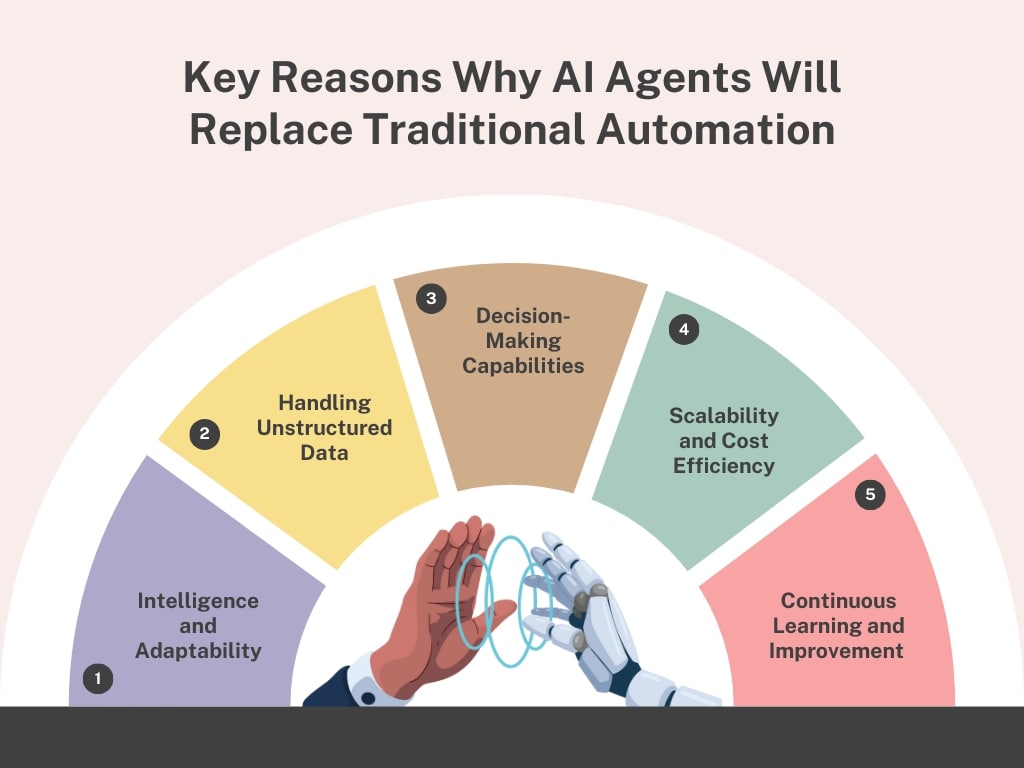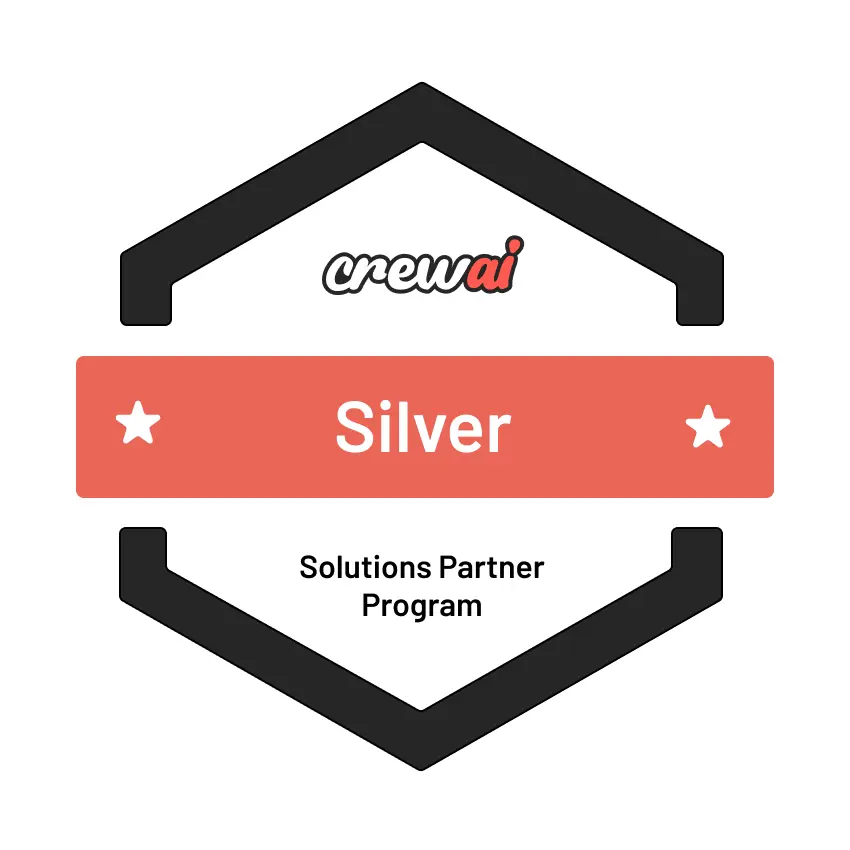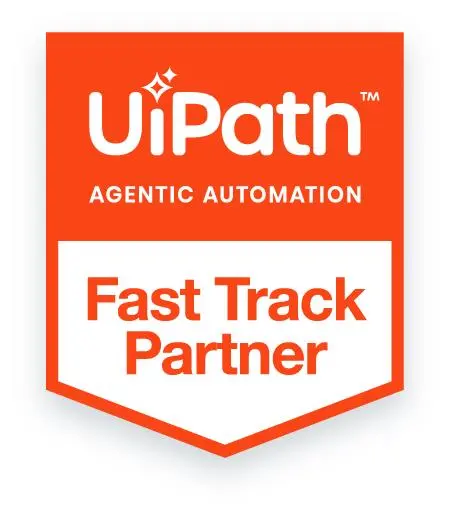
Key Takeaways
- AI agents think, learn, and adapt, while traditional automation strictly follows predefined rules. They handle dynamic situations and improve over time without manual intervention.
- Unlike traditional automation, AI agents analyze unstructured data, such as emails, images, and voice recordings. This allows businesses to automate complex workflows with minimal human effort.
- AI agents use deep learning and predictive analytics to make autonomous decisions. By analyzing data and responding instantly, they improve cybersecurity, finance, and healthcare efficiency.
- AI-powered automation expands without significant infrastructure changes. It reduces operational costs by minimizing human involvement, optimizing workflows, and improving overall business efficiency.
- AI agents will transform the workforce by automating repetitive tasks, enhancing decision-making, and enabling employees to focus on high-value work. Businesses must adapt to this AI-driven future.
As time passed, technologies came and went. Some of them provided numerous benefits, while others lagged. Nevertheless, one thing that never disappointed or failed, even today, is automation. It has stood the test of time, making everything quick and efficient. Automation worked like magic for all businesses, allowing them to grow. Hence, automation has proven itself time and again.
From assembly lines in the manufacturing industry to back-office everyday operations, pre-defined automation has played an imperative role in lessening human intervention. Even though automation solutions like robotic process automation work magic for numerous businesses, they still cannot adapt in difficult times. However, things have worked out better since the emergence of AI agents. These agents use natural language processing, machine learning, and advanced reasoning to function autonomously. Additionally, the agents also consider essential requirements and make swift decisions quickly.
From understanding context to optimizing workflows and gathering knowledge from interactions, AI agents help companies obtain unprecedented agility and efficiency. These agents are immensely beneficial in industries where personalization and variability are paramount. They can examine vast amounts of data, interact with users, and complete automation with zero or less human intervention.
Understanding Traditional Automation vs. AI Agents
Traditional automation refers to rule-based systems that follow predefined logic and workflows. These include robotic process automation (RPA), business process automation (BPA), and macro-based scripting. Some of the essential characteristics of traditional automation consist of the following:
- Functions on guidelines that are set in advance.
- Ask for human intervention in exception cases.
- Does not have the ability to make decisions.
- Only limited to structured data processing.
- Requires extensive maintenance to move further for essential updates
AI agents are also known as autonomous AI systems. They implement deep learning, cognitive computing, and machine learning to ensure that all complex jobs are completed on time. These agents may evaluate data, gain knowledge from previous interactions, and make decisions, distinguishing them from standard automation systems.
- Independent learning
- Adjustable
- Quickly analyzes real-time insights to make decisions.
- Eliminate the need for human intervention.
- Flexible
- Scalable
| Feature | Traditional Automation | AI Agents |
| Rule-based | Yes | No |
| Adaptive Learning | No | Yes |
| Handles Unstructured Data | No | Yes |
| Decision-making | No | Yes |
| Human Intervention | Frequent | Minimal |
| Scalability | Limited | High |
Key Reasons Why AI Agents Will Replace Traditional Automation
As businesses strive for efficiency, agility, and innovation, automation remains at the heart of digital transformation. While traditional automation has significantly enhanced productivity by automating repetitive tasks, its rigid nature limits adaptability and intelligence. On the other hand, AI agents introduce a new era of automation that is dynamic, intelligent, and capable of self-improvement. Below are the key reasons AI agents are set to replace traditional automation.

Intelligence and Adaptability
Traditional automation is rule-based, meaning it follows predefined workflows that must be explicitly programmed. This rigidity makes it unsuitable for dynamic environments where conditions frequently change. For instance, an RPA bot can extract data from structured forms but fails when the format changes or new data types are introduced.
AI agents, powered by machine learning and natural language processing (NLP), can adapt to new scenarios without manual intervention. They continuously learn from historical data, interactions, and contextual cues, enabling them to refine their responses and adjust to evolving business needs. This adaptability is particularly valuable in industries like customer service, where queries vary widely, and supply chain management, where market conditions fluctuate.
Handling Unstructured Data
One of traditional automation’s significant limitations is its reliance on structured data—well-organized, predefined datasets such as spreadsheets and databases. However, in today’s digital space, most business data is unstructured, comprising emails, images, voice recordings, social media posts, and scanned documents.
AI agents excel at processing unstructured data using advanced techniques like computer vision, NLP, and speech recognition. For example, AI can analyze medical images, interpret physician notes, and extract insights from patient histories in healthcare. AI-powered systems can scan and categorize financial reports, contracts, and market trends to assist decision-making in finance. This capability expands automation to domains where structured data alone is insufficient.
Decision-Making Capabilities
Traditional automation tools execute tasks based on predefined rules, requiring explicit programming for every possible scenario. If an exception arises, human intervention is necessary, increasing response time and operational costs. This rigidity limits their ability to handle complex, variable scenarios.
AI agents, on the other hand, employ deep learning models, predictive analytics, and contextual reasoning to make real-time decisions. For example, in cybersecurity, AI-driven agents can analyze network activity, detect anomalies, and autonomously decide whether to block suspicious behavior. Similarly, in financial services, AI can assess risk profiles, predict market fluctuations, and make informed investment decisions. By enabling real-time decision-making, AI agents improve efficiency, accuracy, and responsiveness.
Scalability and Cost Efficiency
Scaling traditional automation solutions often requires significant infrastructure investments and manual reconfiguration. For instance, adding new RPA bots to accommodate growing workloads demands additional licenses, software updates, and ongoing maintenance.
AI agents, however, are inherently scalable. Cloud-based AI models can process increasing volumes of data without the need for extensive infrastructure changes. AI-powered automation also reduces operational costs by minimizing human involvement, lowering error rates, and optimizing workflows. Businesses can reallocate human resources to higher-value tasks, enhancing productivity and innovation.
Continuous Learning and Improvement
A major drawback of traditional automation is its static nature—once deployed, it remains unchanged unless manually updated. This makes it costly and time-consuming to keep up with evolving business requirements and regulatory changes. AI agents, in contrast, continuously learn from new data, interactions, and outcomes. Through reinforcement learning and feedback loops, AI-driven systems become more accurate and efficient.
For example, virtual assistants improve their responses based on user queries, fraud detection models refine their accuracy by analyzing past incidents, and predictive maintenance systems enhance their forecasting abilities with each new dataset. This self-improving capability ensures that AI-driven automation remains relevant and effective in dynamic business environments.
Future Implications: What’s Next?
The rapid adoption of AI agents is transforming automation and reshaping the future of business operations, workforce dynamics, and ethical considerations. As AI evolves, enterprises must prepare for a paradigm shift where intelligent agents assume increasingly complex roles. Below are the key implications of this transition and what businesses should expect shortly.
The Rise of Autonomous Enterprises
The future of automation is about autonomy. AI agents open paths for autonomous enterprises, where systems can make decisions, optimize processes, and execute tasks with minimal human intervention. Most organizations still require human oversight for decision-making in critical areas such as customer service, supply chain management, and IT operations. However, as AI agents become more sophisticated, they can analyze real-time data, predict outcomes, and confidently make autonomous decisions.
For example, AI-driven trading algorithms in finance can autonomously execute trades based on market conditions. AI agents can dynamically reroute shipments in logistics to optimize delivery times and reduce costs. In IT operations, AI-powered monitoring systems can proactively detect and resolve system failures before they impact business continuity.
The transition to autonomous enterprises will not happen overnight, but organizations that embrace AI-driven automation early will gain a competitive edge, improving efficiency and innovation while reducing operational risks.
Integration with Generative AI and Large Language Models
AI agents already leverage machine learning and predictive analytics, but their capabilities will expand significantly with generative AI and large language models (LLMs). Models such as OpenAI’s GPT, Google’s Gemini, and other advanced AI systems make automation more intuitive, conversational, and intelligent.
By integrating AI agents with LLMs, businesses can:
- Enhance customer interactions: AI-powered chatbots and virtual assistants can engage in more natural, human-like conversations, improving customer experience.
- Automate complex content creation: AI can generate reports, draft contracts, and summarize key insights from large datasets.
- Enable context-aware automation: AI agents can understand and process unstructured data, such as emails, documents, and voice commands, making automation more dynamic and adaptive.
For instance, an AI assistant integrated with LLMs can summarize patient records, assist doctors in diagnosis, and even draft medical prescriptions based on historical data and patient symptoms. AI can analyze case laws and generate legal drafts in legal services, significantly reducing manual effort.
Ethical and Compliance Challenges
With AI-driven automation taking center stage, businesses must address the ethical and regulatory challenges that come with it. Some key concerns include:
- Data privacy: AI agents rely on vast amounts of data to make decisions, raising concerns about how sensitive information is collected, stored, and used.
- Bias and fairness: AI models can inadvertently inherit biases from training data, leading to unfair or discriminatory decisions in hiring, lending, and law enforcement.
- Transparency and accountability: Unlike rule-based automation, AI agents operate as “black boxes,” making it difficult to understand how decisions are made. Ensuring the explainability and auditability of AI decisions is crucial.
With AI-driven automation taking center stage, businesses must address the ethical and regulatory challenges that come with it. Some key concerns include:
- Data privacy: AI agents rely on vast amounts of data to make decisions, raising concerns about how sensitive information is collected, stored, and used.
- Bias and fairness: AI models can inadvertently inherit biases from training data, leading to unfair or discriminatory decisions in hiring, lending, and law enforcement.
- Transparency and accountability: Unlike rule-based automation, AI agents operate as “black boxes,” making it difficult to understand how decisions are made. Ensuring the explainability and auditability of AI decisions is crucial.
Governments and regulatory bodies are already developing AI governance frameworks, such as the EU’s AI Act and industry-specific guidelines. Businesses must adopt responsible AI practices to ensure fairness, transparency, and compliance with evolving regulations.
Workforce Transformation
As AI agents take over repetitive and decision-based tasks, the nature of work will evolve. Instead of replacing jobs, AI will transform the workforce, shifting human roles from manual execution to strategic oversight.
Key changes include:
- Reskilling and upskilling: Employees will need training in AI management, prompt engineering, data interpretation, and ethical AI governance.
- New job roles: Roles like AI trainers, automation strategists, and AI compliance officers will become more prevalent.
- Collaboration between AI and humans: Rather than replacing human workers, AI agents will act as co-pilots, assisting professionals in making better decisions and improving efficiency.
For example, junior associates typically spend hours researching case laws in the legal industry. AI-powered legal research tools can now complete this task in minutes, allowing lawyers to focus on higher-value activities such as case strategy and client consultation. Similarly, in finance, AI agents can handle routine audits, freeing financial analysts to focus on risk assessment and investment strategies.
Conclusion
The rise of AI agents marks a pivotal shift in automation, surpassing traditional rule-based systems with intelligence, adaptability, and decision-making capabilities. As industries evolve, businesses must embrace AI-driven automation to remain competitive, scalable, and future-proof. AI agents enhance efficiency, streamline workflows, and unlock new opportunities that traditional automation cannot match.
Ready to advance your automation strategy? Contact Auxiliobits today and transform the way you work with AI!








